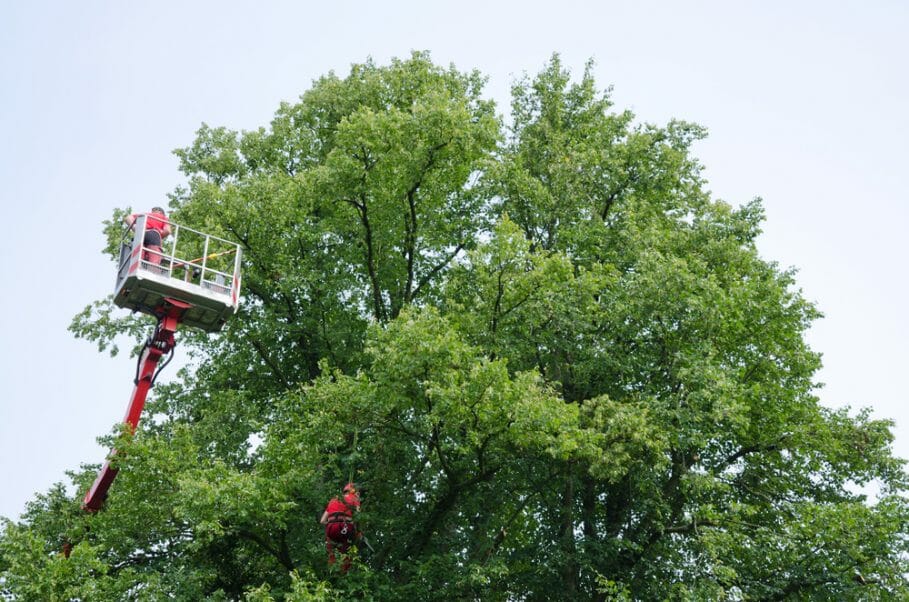A forestry bucket truck is a key instrument for forestry and logging applications. It can make it easier for you to complete your job faster and more efficiently.
This is because they enable workers to safely reach heights that would otherwise be impossible or unsafe to get using a ladder.
They offer excellent maneuverability, making them suitable for a wide range of applications such as tree care, sign maintenance, landscaping, utility line service, and telecom lines.
Choosing a good forestry bucket truck
There are several factors you need to consider when selecting a bucket truck. These include:
- Application
You will want to consider if the bucket truck is designed in a way that will enable you to perform the work required.
Does it have the proper insulation to perform high-voltage work? To what length does the bucket extend?
Do you want a tree truck or one built to handle cable lines? Consider the demands of your business before selecting a forestry bucket truck.

- Size and weight capacity
Do you need a heavy-duty or light-duty bucket truck? This will depend on your individual needs and the vehicle’s weight.
When considering the truck’s size, you should try to find out if it will require a driver with a CDL, though non-CDL truck weight may not need a a pro driver. This is often a requirement for trucks weighing more than 26,000 lbs.
- Working height
What is the highest level that the track can allow you to safely perform your job from its bucket and in a stabilized position?
The height of forestry trucks is usually divided into three categories
- Below 50 feet
- 50-59 feet
- More than 60 feet.
If your working height is in the 40s range, you don’t need to buy a 60-foot truck.
- Platform capacity
This is the total capacity of the occupants, equipment, tools, and other materials that the manufacturer recommends.
Understanding the task you will be performing and the needed capacity will help you narrow down your options.
- Buy or lease
If you cannot afford a forestry truck and don’t want to buy an old one, you can consider leasing.
One of the benefits of leasing is that you can avoid those high prices, especially if you only need the truck for a particular project.

- New or used
Forestry trucks are usually expensive. You will want to consider your budget to decide if it will enable you to buy a new one. If not possible, you can acquire a used one.
However, ensure you understand the technical specifications you should check when buying a used truck.
While the used truck will cost you less, it will have a higher maintenance cost.
Therefore, you must consider if you are ready to pay for higher maintenance when you buy a used truck.
Factors to Consider When Buying a Used Forestry Truck
If you are planning to buy a used truck, here are some specifications that you should be on the lookout for:
- Body, tires, and dump box
You will need to start your inspection by going around the truck and checking for rust, dents, or other major repairs that may be needed.
Look at the box liner and dump box to see if there is any damage. When checking the dump box, consider if it’s’ made of aluminum or steel.
While an aluminum box is usually lightweight compared to a steel box, it can help minimize the cost of fuel in the long run.
Steel, on the other hand, is usually more robust and more durable than aluminum.
Check the tires to see if there is uneven tread wear around the tires’ circumference. Are there any cracks and bent hubcaps?
These could be an indication of truck overloading. Ensure that the same manufacturer makes all tires.
- Rails, frames, and axles
Check if there are any bowing or sagging bends on the rail frames of the truck. If there are sagging ends, this can be an indication of overloading.
Check if there is corrosion or a sign of wear and tear. Are there lift axles in front of the driving tandem? How about tag axles behind the ambitious tandem?
Lift axles are essential as they spread the weight across different axles, enabling the truck to meet various state regulations.
To navigate smoothly, the semi-trailer should have steerable lift axles.
- Check the Cab
Check the cab of the truck to assess its overall condition. Look at the odometer and take note of the mileage.
You can then start the truck to see if all the signals, lights, and gauges work. Drive the forestry bucket truck to see if there is any play on the steering.
- The Engine
If you don’t have enough experience with heavy machinery, you should get a qualified mechanic to help you do the inspection.
But some of the basic things the mechanic should check are signs of leakages, smoke, dirt, strange noise, and wrong cables.
- Logs are critical
This number of miles or hours logged can provide a clear picture of how well the truck was maintained and how long-lasting it will be.
Ensure that all tyres are changed simultaneously so that their mileage will be the same.

Benefits of forestry bucket trucks
There are several benefits of a forestry bucket truck. These include:
- It enables you to get to the hard-to-reach areas. A forestry truck makes it possible for an operator to reach hard-to-reach areas, providing greater flexibility and adding some extra feet on each side.
- Enhances safety. Using a forestry bucket truck to reach higher heights is safer than using a ladder.
- More efficient. Working from a bucket truck will provide you with better freedom of movement, improving your efficiency.
- Dielectrically-rated. Most forestry trucks are usually dielectrically rated, meaning that if they come into contact with power lines, the person in the bucket will remain safe.
- Forestry bucket trucks contain the chipped by-products of trees and branches. They feature steel or aluminium cubed bodies with a removable roof. The body has a frame-mounted hydraulic control that helps to offload the chipped materials.
Safety precautions when using a forestry bucket truck
There are certain guidelines issued by the U.S. Department of Transportation on the requirement for driving a bucket truck safely. These include:
- Proper training of drivers. Before they can drive forestry bucket trucks, drivers need to be well-trained. They should be well aware that the bucket will have exposed equipment above the truck cab’s elevation. They should ensure that there is safe road clearance.
- Material-handling jib. The job for handling the material should be retained in the jib bracket and put in a horizontal and retracted position before travel.
- It’s‘ prohibited to drive with the bucket open. The bucket should instead be returned to the storage position. If any repositioning is to happen, this should only be for short distances.
- Remove tools on the highway. During highway travel, all tools should be removed from the bucket.
- The operator should note the location of all obstructions so that the boom or bucket doesn’t’ come into contact with them.
- The operator should not stand on top of the boom. They should also not belt to a nearby pole.
Forestry bucket truck vs. the rear mount
Bucket trucks can be categorized into two:
Forestry bucket trucks and rear trucks.
The former has a chip box at the back and an airlift placed just behind the cab. The rear mount bucket truck has the airlift installed on the rear axle.
Of the two options, forestry trucks are the most common and most popular. Just like their names suggest, these trucks are more suitable for working around trees. They often have cab guards that prevent trees from falling on the cab.
A common tool that’s used with forestry trucks is a GCRS (Good rigging Control system), which is used to lower the heavy load in a safe and controlled fashion. They have two spools that help to do that.
One of these helps in lowering, while the other one is for lifting. Therefore, the GCRS makes it super easy to raise, lower, and move yard brush and wood embankments.
One benefit of the forestry truck is that it will enable you to do more than one thing inside the truck.
Unlike the rear-mounted truck that will only enable you to perform tree maintenance (removal and pruning), the forestry truck enables you to carry out pruning, removal, chipping, and keep debris in the truck.
Rear-mounted trucks are designed for the delivery of heavy loads. They are commonly used in industrial applications for lifting things like electrical utilities and precast concrete.
They have a higher lifting capacity and enhance lifting stability.
A rear-mounted truck is also more expensive as it’s’ built using more labor-intensive materials.
For instance, it may have an extra set of outriggers that may require more hosing.
Conclusion
A forestry bucket truck can enable you to reach locations that would otherwise be impossible with a ladder.
The trucks are often powered by a combustible engine, even though some have hybrid engines.
The trucks feature a secondary shaft that is responsible for powering the hydraulic rams to guide the lift of the truck in the necessary direction.
With the right forestry bucket truck, you can work safely off-ground with the ability to reposition and the out-of-the-way sports that would otherwise not be reached with a ladder.
Therefore, these trucks can be very instrumental when trimming the tree. By reading this guide, it should be easier to get one that serves your purpose and budget well.





